|
Family: Lybiidae (African barbets and tinkerbirds)
Life
> Eukaryotes >
Opisthokonta
> Metazoa (animals) >
Bilateria >
Deuterostomia > Chordata >
Craniata > Vertebrata (vertebrates) > Gnathostomata (jawed
vertebrates) > Teleostomi (teleost fish) > Osteichthyes (bony fish) > Class:
Sarcopterygii (lobe-finned
fish) > Stegocephalia (terrestrial
vertebrates) > Tetrapoda
(four-legged vertebrates) > Reptiliomorpha > Amniota >
Reptilia (reptiles) >
Romeriida > Diapsida > Archosauromorpha > Archosauria >
Dinosauria
(dinosaurs) > Saurischia > Theropoda (bipedal predatory dinosaurs) >
Coelurosauria > Maniraptora > Aves
(birds) > Order: Piciformes
Species indigenous to southern Africa
|
Lybius
torquatus (Black-collared barbet) The Black-collared barbet is one of the most common barbets
in Africa, being found from the DRC to Kenya, extending south to southern
Africa, occurring in a variety of habitats. It eats mainly fruit, with the rest
of its diet composed of insects and nectar. Both sexes excavate the nest, which is a hole
usually on the underside of dead branches of trees, preferably softwood
trees like Ficus (wild fig). It lays 2-5 eggs, which are incubated by
both sexes, for roughly 18 days. The chicks stay in the nest for about 33-36 days, and are fed fruit
and insects by both parents. |
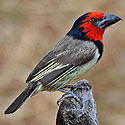 |
|
Pogoniulus
bilineatus (Yellow-rumped tinkerbird, Golden-rumped tinker barbet) The Yellow-rumped tinkerbird occurs from Senegal east
through the Sahel to Uganda, extending south to Angola and the eastern
coast of southern Africa. It mainly eats fruit, with the remainder of its
diet insects and nectar, foraging in the upper canopy of trees. Both sexes
excavate the nest, which is a chamber normally dug into the underside of
dead branches. It lays 2-4, usually 3 eggs, which are incubated by both
sexes, for an unknown period. |
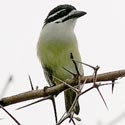 |
|
Pogoniulus
chrysoconus (Yellow-fronted tinkerbird, Yellow-fronted tinker
barbet) The Yellow-rumped tinkerbird occurs from Senegal east
through the Sahel to Uganda, extending south to Angola and the eastern
coast of southern Africa. It mainly eats fruit, with the remainder of its diet
insects and nectar, foraging in the upper canopy of trees. Both sexes excavate
the nest, which is a chamber in the underside of a dead branch. It lays 2-4
eggs, which are incubated by both sexes. |
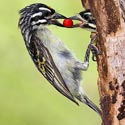 |
|
Pogoniulus
pusillus (Red-fronted tinkerbird, Red-fronted tinker barbet)
The Red-fronted tinkerbird's distribution is split into two isolated
populations - one in north east Africa, the other largely restricted to the
south-eastern coastal area in South Africa. preferring riverine forest and
valley bushveld. It mainly forages in the upper canopy of trees, feeding on
small fruits, especially mistletoes, occasionally hawking insects. Both
sexes excavate the nest, which is usually a hole dug into the underside of a
branch, or an upright dead tree trunk. The 2-4 chicks are cared for by both
parents, who feed them insects and fruit regularly. |
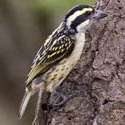 |
|
Pogoniulus
simplex (Green tinkerbird, Green tinker barbet) |
|
|
Stactolaema
leucotis (White-eared barbet) The White-eared barbet occurs in a band extending from
Tanzania and Kenya to Mozambique and KwaZulu-Natal, where it is locally common
in moist woodland. It mainly eats fruit, especially Ficus (wild figs),
foraging in tree canopies. Insects such as grasshoppers and cicadas largely make
up the rest of its diet. It is a cooperative breeder, with the breeding pair and
often helpers excavating the nest, which is a chamber dug into the underside of
dead branches. It lays 3-6, usually 4-5 eggs, which are incubated by both sexes
and the nest helpers, for 14-18 days. In one study, the chicks stayed in the nest for about 39
days, and were fed about 64% insects and 36% fruit (of which 99% is Ficus). |
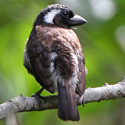 |
|
Stactolaema
olivacea (Green barbet, Woodward's barbet)
The Green barbet occurs in isolated populations in Africa,
including one in southern Africa in the Ongoye forest, KwaZulu-Natal.
Due its extremely localized distribition, it is listed as Threatened in
southern Africa. Its diet is almost exclusively made up of fruit, especially
figs, occasionally eating insects. Both sexes excavate the nest, which is usually a small chamber dug into a
dead, decaying upright tree trunk. With one breeding pair, the female
produced five eggs which were incubated by both sexes for 18 days. The chicks
stayed stayed in the nest for 29 days. |
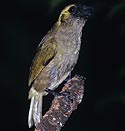 |
|
Stactolaema
whytii (Whyte's barbet) |
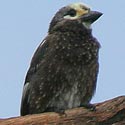 |
|
Trachyphonus
vaillantii (Crested barbet) The Crested barbet occurs from Angola and Zambia south to
southern Africa, where it is common in a wide range of woodland habitats. It is
omnivorous, eating largely insects when fruit is scarce, although the chicks are
fed exclusively insects. Both sexes excavate the nest, which consists of a
chamber dug into the underside of a dead branch, defended vigorously against
other hole-nesting birds. It lays 2-5, usually 3-4 eggs which are incubated by
both sexes for about 17 days. The chicks stay in the nest for about 31 days, all
the while the breeding pair enlarge the entrance hole as they grow. |
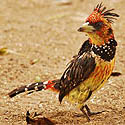 |
|
Tricholaema
leucomelas (Acacia pied barbet, Pied barbet)
The Acacia pied barbet is nearly endemic to southern Africa, its range
extending marginally into Angola and Zambia. It mainly lives in semi-arid
savanna, but it has recently colonised grasslands, fynbos, orchards and
suburban gardens, due to the introduction of alien tree species, especially
Acacia. It feeds mainly on fruit, as well as insects, Aloe
nectar and flower petals. Both sexes excavate the nest, which is a chamber
dug into the underside of dead branches, laying 2-4 eggs, which are
incubated by both sexes, for 12-18 days. The chicks stay in the nest for
about 35 days, and are fed by both parents. |
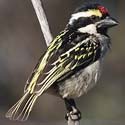 |
|
